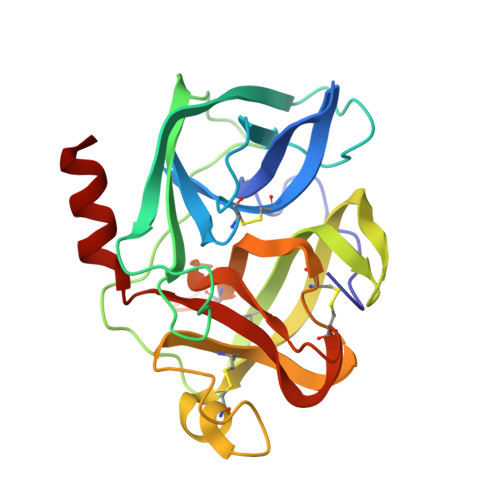Reaction of porcine pancreatic elastase with 7-substituted 3-alkoxy-4-chloroisocoumarins: design of potent inhibitors using the crystal structure of the complex formed with 4-chloro-3-ethoxy-7-guanidinoisocoumarin.
Powers, J.C., Oleksyszyn, J., Narasimhan, S.L., Kam, C.M.(1990) Biochemistry 29: 3108-3118
- PubMed: 2337582
- DOI: https://doi.org/10.1021/bi00464a030
- Primary Citation of Related Structures:
8EST - PubMed Abstract:
The crystal structure of the acyl enzyme formed upon inhibition of porcine pancreatic elastase (PPE) by 4-chloro-3-ethoxy-7-guanidinoisocoumarin has been determined at a 1.85-A effective resolution. The chlorine atom is still present in this acyl enzyme, in contrast to the previously reported structure of the 7-amino-4-chloro-3-methoxyisocoumarin-PPE complex where the chlorine atom has been replaced by an acetoxy group. The guanidino group forms hydrogen bonds with the carbonyl group and side-chain hydroxyl group of Thr-41, and the acyl carbonyl group has been twisted out of the oxyanion hole. Molecular modeling indicates that the orientation of the initial Michaelis enzyme-inhibitor complex is quite different from that of the acyl enzyme since simple reconstruction of the isocoumarin ring would result in unfavorable interactions with Ser-195 and His-57. Molecular models were used to design a series of new 7-(alkylureido)- and 7-(alkylthioureido)-substituted derivatives of 3-alkoxy-7-amino-4-chloroisocoumarin as PPE inhibitors. All the 3-ethoxyisocoumarins were better inhibitors than those in the 3-methoxy series due to better interactions with the S1 pocket of PPE. The best ureido inhibitor also contained a tert-butylureido group at the 7-position of the isocoumarin. Due to a predicted interaction with a small hydrophobic pocket on the surface of PPE, this isocoumarin and a related phenylthioureido derivative are among the best irreversible inhibitors thus far reported for PPE (kobs/[I] = 8100 M-1 s-1 and 12,000 M-1 s-1). Kinetic studies of the stability of enzyme-inhibitor complexes suggest that many isocoumarins are alkylating the active site histidine at pH 7.5 via a quinone imine methide intermediate, while at pH 5.0, the predominant pathway appears to be simple formation of a stable acyl enzyme derivative.
Organizational Affiliation:
School of Chemistry, Georgia Institute of Technology, Atlanta 30332.

















